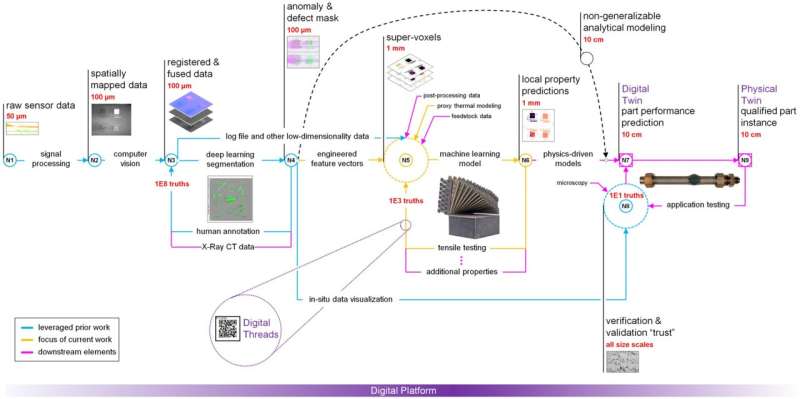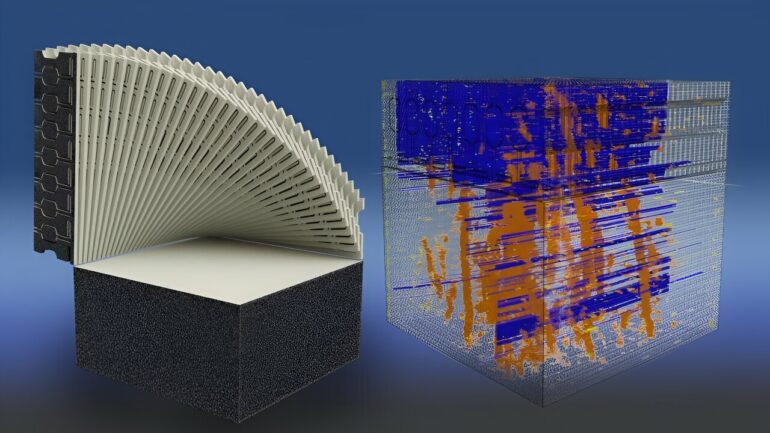The Department of Energy’s Oak Ridge National Laboratory has publicly released a new set of additive manufacturing data that industry and researchers can use to evaluate and improve the quality of 3D-printed components. The breadth of the datasets can significantly boost efforts to verify the quality of additively manufactured parts using only information gathered during printing, without requiring expensive and time-consuming post-production analysis.
Data has been routinely captured over a decade at DOE’s Manufacturing Demonstration Facility, or MDF, at ORNL, where early-stage research in advanced manufacturing coupled with comprehensive analysis of the resulting components has created a vast trove of information about how 3D printers perform. Years of experience pushing the boundaries of 3D printing with novel materials, machines and controls have provided ORNL with the unique ability to develop and share comprehensive datasets. The newest dataset is now available for free through an online platform.
The conventional manufacturing industry benefits from centuries of quality-control experience. However, additive manufacturing is a newer, non-traditional approach that typically relies on expensive evaluation techniques for monitoring the quality of parts. These techniques might include destructive mechanical testing or non-destructive X-ray computed tomography, which creates detailed cross-sectional images of objects without damaging them.
Although informative, these techniques have limitations—for example, they are difficult to perform on large parts. ORNL’s comprehensive 3D printing datasets can be used to train machine learning models to improve quality assessment for any type of component.
“We are providing trustworthy datasets for industry to use toward certification of products,” said Vincent Paquit, head of the ORNL Secure and Digital Manufacturing section. “This is a data management platform structured to tell a complete story around an additively manufactured component. The goal is to use in-process measurements to predict the performance of the printed part.”

Graphical representation of the implemented AIR. This paper focuses on nodes N5 and N6 (orange), leveraging prior work by the authors shown at nodes N1, N2, N3, N4, and N8 (blue). Approximate spatial resolutions of data at each node are shown in red. Approximations for the number of ground truth values required for each feedback loop are also shown in red. Key elements of the digital platform that supported the implementation of the relay are shown in purple. The black dashed line from N4 to N7 represents a possible alternate pathway for predicting localized properties. © Materials (2023). DOI: 10.3390/ma16237293
The 230-gigabyte dataset covers the design, printing and testing of five sets of parts with different geometric shapes, all made using a laser powder bed printing system. Researchers can access machine health sensor data, laser scan paths, 30,000 powder bed images and 6,300 tests of the material’s tensile strength.
This is the fourth and most extensive in a series of additive manufacturing datasets ORNL is making publicly available. Previous datasets have focused on the construction of parts made with electron beam powder bed and binder jet printing at the MDF. The datasets can be searched for specific information needed to understand rare failure mechanisms, develop online analysis software or model material properties.
The MDF, supported by DOE’s Advanced Materials and Manufacturing Technologies Office, is a nationwide consortium of collaborators working with ORNL to innovate, inspire and catalyze the transformation of U.S. manufacturing.
ORNL researchers demonstrated how to apply the datasets by training a machine learning algorithm using measurements taken during the 3D-printing process. Paired with high-performance computing methods, the trained algorithm can reliably predict whether a mechanical test will be successful. It also made 61% fewer errors in predicting a part’s ultimate tensile strength.
Correlating in-process measurements with the final product is key to providing confidence about when an additional test of the part is needed—and when it’s not.
“This is a key enabler to additive manufacturing at industry scale, because they can’t afford to characterize every piece,” Paquit said. “Using this data can help them capture the link between intent, manufacturing and outcomes.”
More information:
Luke Scime et al, A Co-Registered In-Situ and Ex-Situ Tensile Properties Dataset from a Laser Powder Bed Fusion Additive Manufacturing Process (Peregrine v2023-11) (2023). DOI: 10.13139/ornlnccs/2001425
Provided by
Oak Ridge National Laboratory
Citation:
Free 3D-printing datasets enable analysis, confidence in printed parts (2024, July 18)



